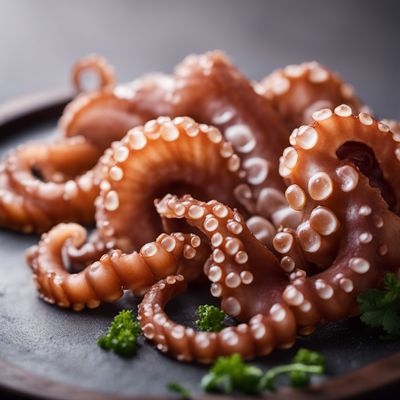
Ingredient
Octopus, common
The Ocean's Delicacy
Octopus is a cephalopod mollusk known for its soft, chewy flesh and mild, slightly sweet flavor. Its appearance is characterized by long tentacles and a bulbous head, often associated with underwater creatures. When cooked properly, octopus becomes tender and succulent, making it a popular choice in various cuisines around the world.
Origins and history
Octopus has a rich history in Mediterranean and Asian cultures, where it has been consumed for centuries. It was highly valued by ancient Greeks and Romans, who considered it a delicacy. Today, octopus is enjoyed in many coastal regions and is a staple in dishes like Greek octopus stew and Japanese takoyaki.
Nutritional information
Octopus is a low-calorie, high-protein ingredient that also provides essential vitamins and minerals such as vitamin B12, selenium, and iron.
Allergens
Shellfish allergy.
How to select
When selecting octopus, look for specimens with firm, intact flesh and a fresh, oceanic smell. Avoid any signs of discoloration, sliminess, or ammonia-like odor, as these indicate poor quality or spoilage. Fresh octopus should have a vibrant, pinkish color and be free from any visible damage or bruising.
Storage recommendations
To maintain its freshness, store raw octopus in the refrigerator at a temperature between 32°F and 39°F (0°C and 4°C). Keep it wrapped in a damp cloth or paper towel to prevent it from drying out. Cooked octopus can be stored in an airtight container in the refrigerator for up to 3 days.
How to produce
Octopus is typically caught in the wild, but it can also be farmed in controlled environments. To produce octopus, one would need access to a suitable marine habitat, such as a large tank or pool, and a reliable source of food for the octopus to feed on. It requires careful monitoring of water quality and temperature to ensure optimal growth and survival.
Preparation tips
Octopus can be prepared in various ways, including grilling, boiling, or braising. To tenderize the flesh, it is often recommended to either freeze it before cooking or to simmer it with a cork or onion. Popular dishes featuring octopus include Spanish pulpo a la gallega, Italian octopus salad, and Korean stir-fried octopus.
Substitutions
Squid, cuttlefish, calamari
Culinary uses
Octopus is commonly used in Mediterranean, Asian, and seafood-based cuisines. It is often featured in salads, stews, pasta dishes, and sushi. Its tender texture and mild flavor make it a versatile ingredient that pairs well with bold spices, citrus, and fresh herbs.
Availability
Octopus is commonly available in coastal regions around the world, including the Mediterranean, Japan, Korea, Spain, Portugal, and Greece.


